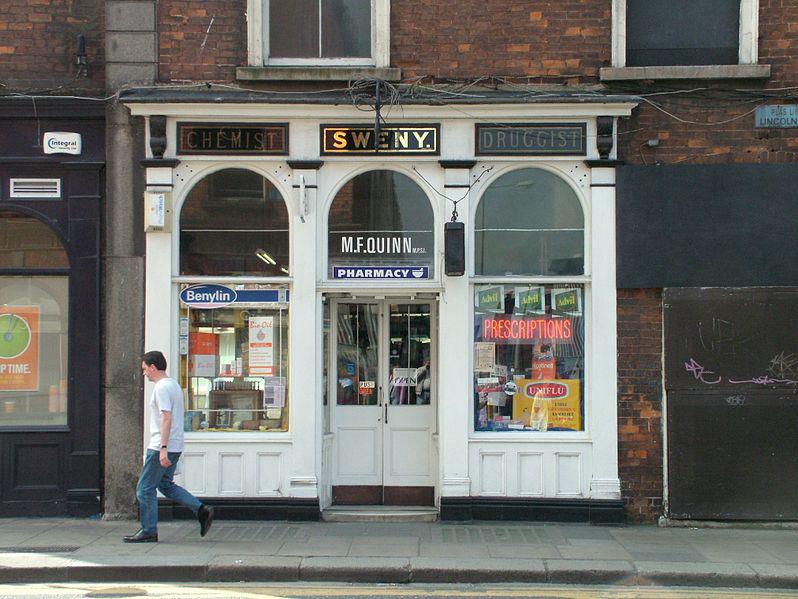In the “Lotus Eaters” chapter of Joyce’s Ulysses, Leopold Bloom steps into Sweny’s, a chemist shop on Lombard Street, to have some skin lotion made for his wife, Molly, who is at home, in bed, waiting for her lover to come around. While he’s there, Bloom buys some lemon soap for himself to use at the Turkish baths, and makes a firm stream-of-consciousness call on whether he’s going to get some masturbation squared away while he’s at it. (“Also I think I. Yes I. Do it in the bath. Curious longing I. Water to water. Combine business with pleasure.”) Bloom watches old Sweny, the pharmacist, as he makes up Molly’s lotion, considering his “shrivelled smell” and his “shrunken skull,” and reflecting on what a lifetime of “living all the day among herbs, ointments, disinfectants” would be likely to do to a person. Even in Joyce’s 1904, the shop seems a relic of an older time, and causes Bloom to think as he departs the store of the ancient practice of alchemy, and the quest for the philosopher’s stone.
Now, 110 years after benefiting from Bloom’s fictional custom, and 167 years after first opening its doors, Sweny’s pharmacy—which is also a nonfictional establishment on Dublin’s nonfictional Lombard Street—is still more or less exactly as Bloom left it. Up until a few years back, the place remained a pharmacy, but is now a tiny museum—or more accurately an eccentric little shrine to James Joyce and his most famous work, where you can stand in the exact spot where Bloom stood on June 16, 1904, and where you can still buy a bar of the same unique “sweet lemony wax” scented soap. It also holds regular group readings in various languages from Joyce’s books, and has established itself as one of Dublin’s most intriguing and endearing cultural landmarks.
But for all the ballast of its literary past, Sweny’s future has been looking very uncertain over the last couple of weeks. Thanks to a significant hike in tax rates, and to the Dublin city council’s unwillingness to recognize that it can no longer be classed as a commercial property, the establishment—which is kept afloat largely by charitable donations and the sale of lemon soap, and is staffed entirely by volunteers—is now in a financially precarious position. Its staff and supporters fear that, after this weekend, it may not live to see another Bloomsday.
Wendy Conroy, one of Sweny’s 20 or so volunteers, told me over the phone that the city authorities have been maintaining an “ominous silence” on the matter, despite the increased public and media interest in Sweny’s plight. National Geographic, she told me, sent a photographer to Dublin this week specifically to photograph the shop in its state of Joycean suspension, which has all of a sudden become a precarious one. “Ted Koppel,” she said, “came in yesterday with his wife Grace Anne. I think they were here on holidays. They were both lovely. He read aloud from the ending of ‘The Dead,’ which was very nice. And they both signed our petition. Apparently, he’s a famous American broadcaster. Personally, I’d never heard of him.”
The volunteers have gathered enough money—from friends, family members, and visitors to the shrine—to pay the outstanding sum of €5,000 for this year, but if the city continues to demand they pay commercial rates, it seems doubtful that Sweny’s will be able to continue in its current form. “Fáilte Ireland did an inspection on our eligibility for funding,” Wendy told me, referring to the state authority for the development and promotion of tourism. “They sent some fancy-schmancy accountancy firm in, and they nearly had a stroke when they saw the place. ‘Where’s your cash register?’ they said. So we were turned down for funding by Fáilte Ireland. But that hasn’t stopped them using us to promote Dublin tourism.”
In that passage in Ulysses, as he waits for old Sweny to finish putting together Molly’s potions behind the counter, Bloom inwardly observes that “chemists rarely move. Their green and gold beaconjars too heavy to stir.” The observation has certainly remained true of Sweny’s, whose beaconjars can still be seen behind that same counter—at least for now. Modern Dublin as a whole is by no means lacking in physical links to the city of Ulysses—in fact it can, as I’ve written, sometimes seem like an exhaustive urban index to Joyce’s work. The National Library, Glasnevin Cemetery, the National Maternity Hospital on Holles Street, Sandymount Strand: All these place and more are locations from Ulysses that still remain largely as they were when Joyce’s characters frequented them. But all those places are larger than their Joycean associations; their presence in the novel is only one element of their place in the city’s life. What’s special about the tiny time capsule of Sweny’s pharmacy is that it when you walk through its door, you are in a place that is pure, concentrated Ulysses. There’s no other place that quite has that quality, and it would be a sad thing if it were to be lost.
